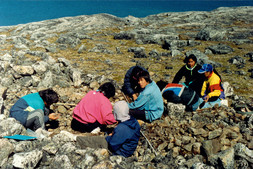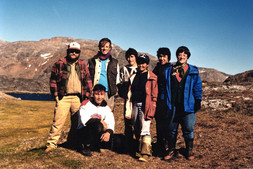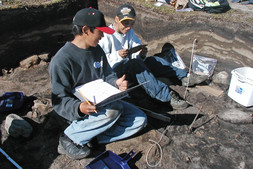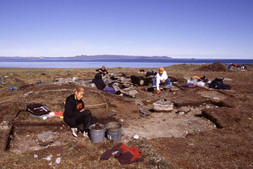- About
- Discovering Archaeology
- Projects and Activities
- Online Resources
- References
Archaeology
Archaeological fieldwork schools
The Avataq Cultural Institute’s archaeological fieldwork education programs
Since its founding in 1985, the Avataq Cultural Institute’s archaeology department has organized regular archaeological fieldwork schools for Nunavik’s Inuit youth. These programs offer Inuit students an opportunity to actively participate in various archaeological projects carried out throughout Nunavik, under the guidance of Avataq’s archaeologists. The programs thus provide students with new bases of knowledge and an awareness of the importance of preserving archaeological sites and artifacts.
Background
Avataq’s first fieldwork school was held in 1985 as part of the Quaqtaq project at site JgEj3. Young people from all over Nunavik participated in the dig over a two-year period. The program’s initial success in capturing the interest of the students inspired us to invite them back to the field, this time to participate in the excavation of Nunaingok. This large-scale project was carried out in 1987 and 1988 at site JcDe-1, located on the Quebec–Labrador peninsula. Since then, several fieldwork schools have been held throughout the region, most notably in Inukjuak (Natturalik, 1991; Drayton Island, 2007-2008) and in the Hudson Strait (Kangiqsujuaq, 2003; Tayara/Salluit, 2003-2006).
Archaeological apprenticeships
Our fieldwork schools generally last 4 to 6 weeks, depending on the project. Inuit students between 13 and 18 years of age receive training from Avataq archaeologists that allows them to spend their summer as archaeological technicians. They are taught the basics of archaeology (such as the cultural periods in Nunavik and the concept of stratigraphy), as well as the various methods employed in excavation (such as how to use a trowel without damaging or moving artifacts, note-taking, photography, drawing individual excavation squares, taking theodolite measurements, etc.).
Future projects
Avataq’s archaeology department hopes to continue to combine these fieldwork education programs with our regular work, as they not only allow us to carry out further research, but also promote awareness among local youth of the importance of preserving their cultural heritage and the value of relics from the region’s past.




